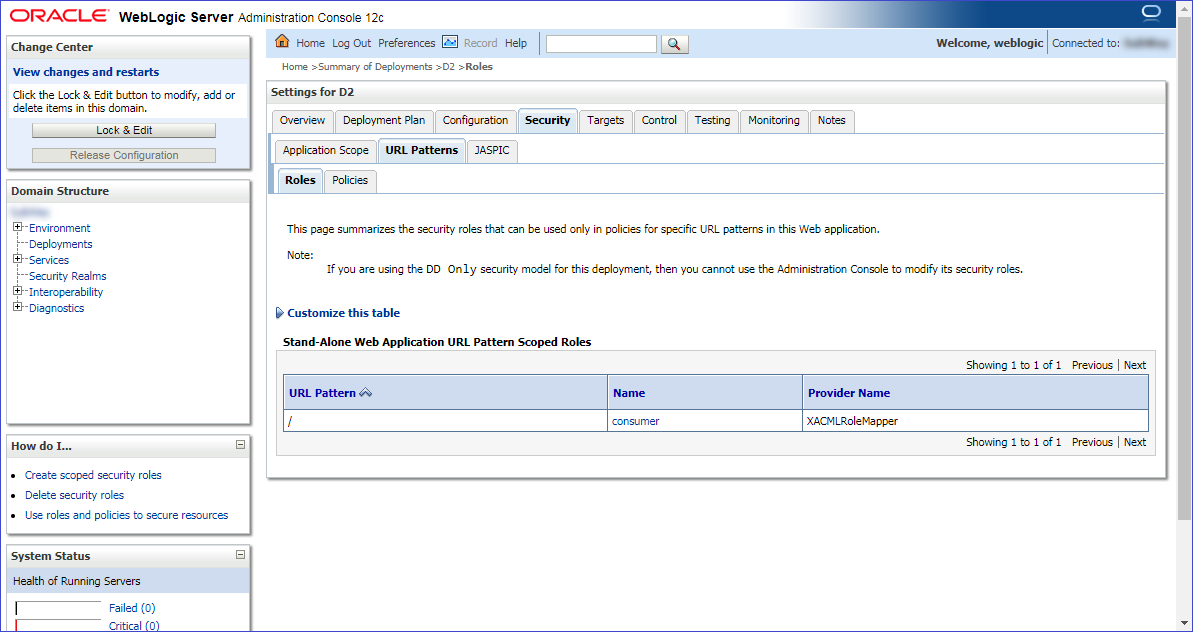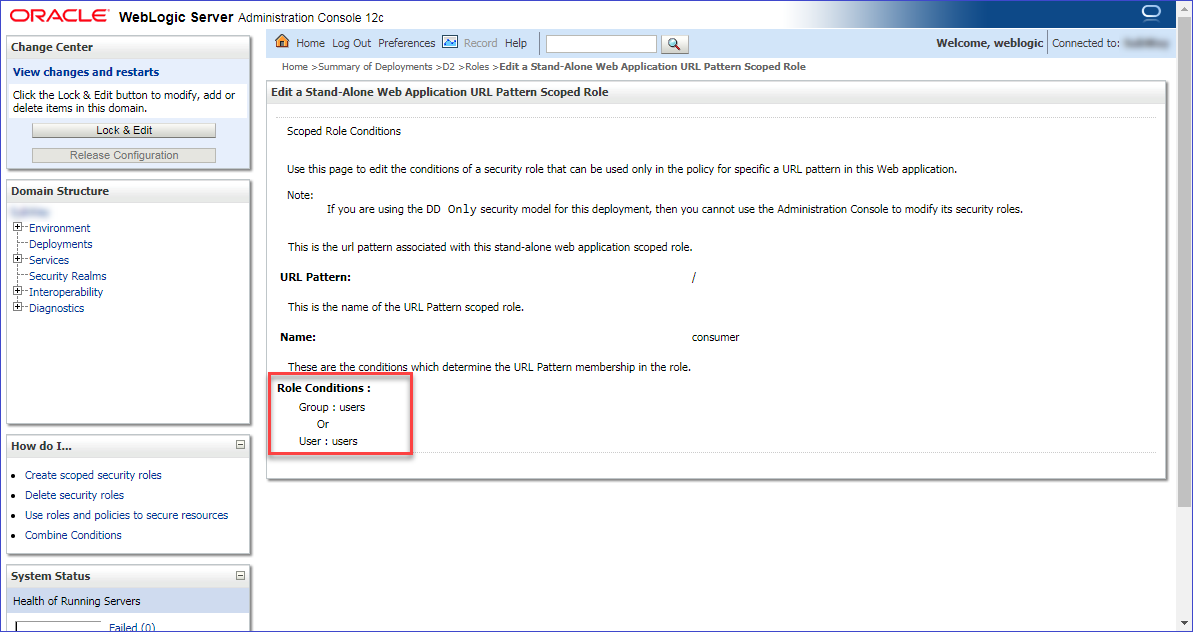Earlier today, I posted another blog with almost the same title but the similarities stop here. The thing is that when you access your application, there aren’t much error codes possible so if there is an issue, it’s often the same generic message that is being displayed on the browser.
To get some background on the issue that I will present below, we are usually setting up the WebLogic Server, enabling the SSO on the WLS level, aso… Then there are different Application Teams that prepare their specific application war files and deploy them into our WLS. Since all teams are using standard procedures and IQs to deploy all that, the applications are properly working in SSO 99% of the time but human errors can happen, especially in the dev environments where there are a less verification…
So after deploying their customized war files, an Application Team tried to access it using the SSO URL but then got a ‘403 – Forbidden’ error message, crap. As we are responsible for the whole platform, they are usually directly coming to us so that we can check what is wrong. So as always: enable the debug logs, find out what the issue is, where a mistake was done and how to solve it. In this case (and contrary to the previous blog), the SAML2 response was correct and accepted by WebLogic so the SSO process was already going one step further, this is why I will just skip the first part of the logs (as well as the LDAP authentication & retrieval of groups) and only show what is happening afterwards (so no Atn but only Atz):
<Nov 12, 2017, 5:43:25,15 PM UTC> <Debug> <SecurityAtz> <AuthorizationManager will use common security for ATZ>
<Nov 12, 2017, 5:43:25,15 PM UTC> <Debug> <SecurityAtz> <weblogic.security.service.WLSAuthorizationServiceWrapper.isAccessAllowed>
<Nov 12, 2017, 5:43:25,15 PM UTC> <Debug> <SecurityAtz> <com.bea.common.security.internal.service.AccessDecisionServiceImpl.isAccessAllowed Identity=Subject: 3
Principal = class weblogic.security.principal.WLSUserImpl("PATOU_MORGAN")
Principal = class weblogic.security.principal.WLSGroupImpl("readers")
Principal = class weblogic.security.principal.WLSGroupImpl("superusers")
>
<Nov 12, 2017, 5:43:25,16 PM UTC> <Debug> <SecurityAtz> <com.bea.common.security.internal.service.AccessDecisionServiceImpl.isAccessAllowed Roles=[ "Anonymous" ]>
<Nov 12, 2017, 5:43:25,16 PM UTC> <Debug> <SecurityAtz> <com.bea.common.security.internal.service.AccessDecisionServiceImpl.isAccessAllowed Resource=type=<url>, application=D2, contextPath=/D2, uri=/X3_Portal.jsp, httpMethod=GET>
<Nov 12, 2017, 5:43:25,16 PM UTC> <Debug> <SecurityAtz> <com.bea.common.security.internal.service.AccessDecisionServiceImpl.isAccessAllowed Direction=ONCE>
<Nov 12, 2017, 5:43:25,16 PM UTC> <Debug> <SecurityAtz> <XACML Authorization isAccessAllowed(): input arguments:>
<Nov 12, 2017, 5:43:25,16 PM UTC> <Debug> <SecurityAtz> < Subject: 3
Principal = weblogic.security.principal.WLSUserImpl("PATOU_MORGAN")
Principal = weblogic.security.principal.WLSGroupImpl("readers")
Principal = weblogic.security.principal.WLSGroupImpl("superusers")
>
<Nov 12, 2017, 5:43:25,16 PM UTC> <Debug> <SecurityAtz> < Roles:Anonymous>
<Nov 12, 2017, 5:43:25,16 PM UTC> <Debug> <SecurityAtz> < Resource: type=<url>, application=D2, contextPath=/D2, uri=/X3_Portal.jsp, httpMethod=GET>
<Nov 12, 2017, 5:43:25,16 PM UTC> <Debug> <SecurityAtz> < Direction: ONCE>
<Nov 12, 2017, 5:43:25,16 PM UTC> <Debug> <SecurityAtz> < Context Handler: >
<Nov 12, 2017, 5:43:25,16 PM UTC> <Debug> <SecurityAtz> <Accessed Subject: Id=urn:oasis:names:tc:xacml:2.0:subject:role, Value=[Anonymous]>
<Nov 12, 2017, 5:43:25,16 PM UTC> <Debug> <SecurityAtz> <Evaluate urn:oasis:names:tc:xacml:1.0:function:string-at-least-one-member-of([consumer,consumer],[Anonymous]) -> false>
<Nov 12, 2017, 5:43:25,16 PM UTC> <Debug> <SecurityAtz> <primary-rule evaluates to NotApplicable because of Condition>
<Nov 12, 2017, 5:43:25,16 PM UTC> <Debug> <SecurityAtz> <urn:bea:xacml:2.0:entitlement:resource:type@E@Furl@G@M@Oapplication@ED2@M@OcontextPath@E@UD2@M@Ouri@E@U@K@M@OhttpMethod@EGET, 1.0 evaluates to Deny>
<Nov 12, 2017, 5:43:25,17 PM UTC> <Debug> <SecurityAtz> <XACML Authorization isAccessAllowed(): returning DENY>
<Nov 12, 2017, 5:43:25,17 PM UTC> <Debug> <SecurityAtz> <com.bea.common.security.internal.service.AccessDecisionServiceImpl.isAccessAllowed AccessDecision returned DENY>
<Nov 12, 2017, 5:43:25,17 PM UTC> <Debug> <SecurityAtz> <com.bea.common.security.internal.service.AuthorizationServiceImpl.isAccessAllowed returning adjudicated: false>
As you can see at the end of the log, the access is denied (‘isAccessAllowed returning adjudicated: false’) and if you check the previous lines, you can see that this is actually because the function ‘string-at-least-one-member-of’ is expecting the user to have the role ‘consumer’ but here the user only have the role ‘Anonymous’. There is a mismatch and therefore the access is denied which caused the ‘403 – Forbidden’ message. So where are those roles assigned? It is actually not on the IdP Partner or LDAP side but on the WebLogic side directly, or rather on the Application side to be more precise…
When working with SSO solutions, there are some additional configurations that you will need to incorporate to your application war file like for example what is transport mode for all communications, which URLs (/context) are not to be authenticated through SSO and which ones are, which roles the users need, aso… This is all done (for WebLogic) inside the web.xml and weblogic.xml.
In this case, the ‘consumer’ role shown above is defined in the web.xml file inside the ‘<auth-constraint>’ (Authorization constraint) so it basically says that this is the only authorized role to perform constrained requests. This is an example of configuration that you can put in your web.xml (this one is an extract of what can be done for Documentum D2 with SAML2 SSO):
[weblogic@weblogic_server_01 D2]$ tail -50 WEB-INF/web.xml
<security-constraint>
<web-resource-collection>
<web-resource-name>SSO Public</web-resource-name>
<description>Non-authenticated resources</description>
<url-pattern>/help/en/*</url-pattern>
<url-pattern>/resources/*</url-pattern>
...
<http-method>GET</http-method>
<http-method>POST</http-method>
</web-resource-collection>
</security-constraint>
<security-constraint>
<web-resource-collection>
<web-resource-name>SSO Private</web-resource-name>
<description>Authenticated resources</description>
<url-pattern>/*</url-pattern>
<http-method>GET</http-method>
<http-method>POST</http-method>
</web-resource-collection>
<auth-constraint>
<description>Authorized role</description>
<role-name>consumer</role-name>
</auth-constraint>
<user-data-constraint>
<description>User Data</description>
<transport-guarantee>CONFIDENTIAL</transport-guarantee>
</user-data-constraint>
</security-constraint>
<security-role>
<role-name>consumer</role-name>
</security-role>
...
[weblogic@weblogic_server_01 D2]$
So the above configuration exactly match what WebLogic requires and what is shown in the logs. The user must have a role that is ‘consumer’ to be able to access the Application. The only question left is why the users aren’t assigned to this role if they have been authenticated via the SAML2 SSO and LDAP and that’s where the issue is in this case. In the web.xml, you can define what security should apply to your application but for the assignment to the security roles, you should rather take a look at the weblogic.xml file. You can assign users using their principals (coming from the WLS Security Realm) but it is usually better to use groups instead to avoid managing users individually (more information there). So you already understood it, the issue in this case was simply that the Application Team configured the security roles on the web.xml file but they forgot the assignments on the weblogic.xml and therefore the issue was solved by simply adding the following lines in this file:
[weblogic@weblogic_server_01 D2]$ tail -5 WEB-INF/weblogic.xml
<security-role-assignment>
<role-name>consumer</role-name>
<principal-name>users</principal-name>
</security-role-assignment>
</weblogic-web-app>
[weblogic@weblogic_server_01 D2]$
With these four simple lines, all existing users from the LDAP (that is configured in our WebLogic) are getting automatically granted the role ‘consumer’ and are therefore allowed to access the application.
From the WebLogic Administration Console, you can check what is the assignment of a security role using these steps:
- Login to the Admin Console using your weblogic account
- Navigate to the correct page: DOMAIN > Deployments > YourApp (click on the name) > Security > URL Patterns > Roles > YourRole (click on the name)
The list of roles can be seen here:
Then after clicking on the name of the role, you can see the conditions for the assignments:
To compare the logs before/after, this is what is being printed to the logs after the correction:
<Nov 12, 2017, 6:30:55,10 PM UTC> <Debug> <SecurityAtz> <AuthorizationManager will use common security for ATZ>
<Nov 12, 2017, 6:30:55,10 PM UTC> <Debug> <SecurityAtz> <weblogic.security.service.WLSAuthorizationServiceWrapper.isAccessAllowed>
<Nov 12, 2017, 6:30:55,10 PM UTC> <Debug> <SecurityAtz> <com.bea.common.security.internal.service.AccessDecisionServiceImpl.isAccessAllowed Identity=Subject: 3
Principal = class weblogic.security.principal.WLSUserImpl("PATOU_MORGAN")
Principal = class weblogic.security.principal.WLSGroupImpl("readers")
Principal = class weblogic.security.principal.WLSGroupImpl("superusers")
>
<Nov 12, 2017, 6:30:55,11 PM UTC> <Debug> <SecurityAtz> <com.bea.common.security.internal.service.AccessDecisionServiceImpl.isAccessAllowed Roles=[ "Anonymous" "consumer" ]>
<Nov 12, 2017, 6:30:55,11 PM UTC> <Debug> <SecurityAtz> <com.bea.common.security.internal.service.AccessDecisionServiceImpl.isAccessAllowed Resource=type=<url>, application=D2, contextPath=/D2, uri=/X3_Portal.jsp, httpMethod=GET>
<Nov 12, 2017, 6:30:55,11 PM UTC> <Debug> <SecurityAtz> <com.bea.common.security.internal.service.AccessDecisionServiceImpl.isAccessAllowed Direction=ONCE>
<Nov 12, 2017, 6:30:55,11 PM UTC> <Debug> <SecurityAtz> <XACML Authorization isAccessAllowed(): input arguments:>
<Nov 12, 2017, 6:30:55,11 PM UTC> <Debug> <SecurityAtz> < Subject: 3
Principal = weblogic.security.principal.WLSUserImpl("PATOU_MORGAN")
Principal = weblogic.security.principal.WLSGroupImpl("readers")
Principal = weblogic.security.principal.WLSGroupImpl("superusers")
>
<Nov 12, 2017, 6:30:55,11 PM UTC> <Debug> <SecurityAtz> < Roles:Anonymous, consumer>
<Nov 12, 2017, 6:30:55,11 PM UTC> <Debug> <SecurityAtz> < Resource: type=<url>, application=D2, contextPath=/D2, uri=/X3_Portal.jsp, httpMethod=GET>
<Nov 12, 2017, 6:30:55,11 PM UTC> <Debug> <SecurityAtz> < Direction: ONCE>
<Nov 12, 2017, 6:30:55,11 PM UTC> <Debug> <SecurityAtz> < Context Handler: >
<Nov 12, 2017, 6:30:55,12 PM UTC> <Debug> <SecurityAtz> <Accessed Subject: Id=urn:oasis:names:tc:xacml:2.0:subject:role, Value=[Anonymous,consumer]>
<Nov 12, 2017, 6:30:55,12 PM UTC> <Debug> <SecurityAtz> <Evaluate urn:oasis:names:tc:xacml:1.0:function:string-at-least-one-member-of([consumer,consumer],[Anonymous,consumer]) -> true>
<Nov 12, 2017, 6:30:55,12 PM UTC> <Debug> <SecurityAtz> <primary-rule evaluates to Permit>
<Nov 12, 2017, 6:30:55,12 PM UTC> <Debug> <SecurityAtz> <urn:bea:xacml:2.0:entitlement:resource:type@E@Furl@G@M@Oapplication@ED2@M@OcontextPath@E@UD2@M@Ouri@E@U@K@M@OhttpMethod@EGET, 1.0 evaluates to Permit>
<Nov 12, 2017, 6:30:55,12 PM UTC> <Debug> <SecurityAtz> <XACML Authorization isAccessAllowed(): returning PERMIT>
<Nov 12, 2017, 6:30:55,12 PM UTC> <Debug> <SecurityAtz> <com.bea.common.security.internal.service.AccessDecisionServiceImpl.isAccessAllowed AccessDecision returned PERMIT>
<Nov 12, 2017, 6:30:55,12 PM UTC> <Debug> <SecurityAtz> <com.bea.common.security.internal.service.AuthorizationServiceImpl.isAccessAllowed returning adjudicated: true>
Access is allowed. 🙂


![Thumbnail [60x60]](https://www.dbi-services.com/blog/wp-content/uploads/2022/08/MOP_web-min-scaled.jpg)
![Thumbnail [90x90]](https://www.dbi-services.com/blog/wp-content/uploads/2022/08/GME_web-min-scaled.jpg)
![Thumbnail [90x90]](https://www.dbi-services.com/blog/wp-content/uploads/2022/08/PLE_web-min-scaled.jpg)
![Thumbnail [90x90]](https://www.dbi-services.com/blog/wp-content/uploads/2022/08/ATR_web-min-scaled.jpg)